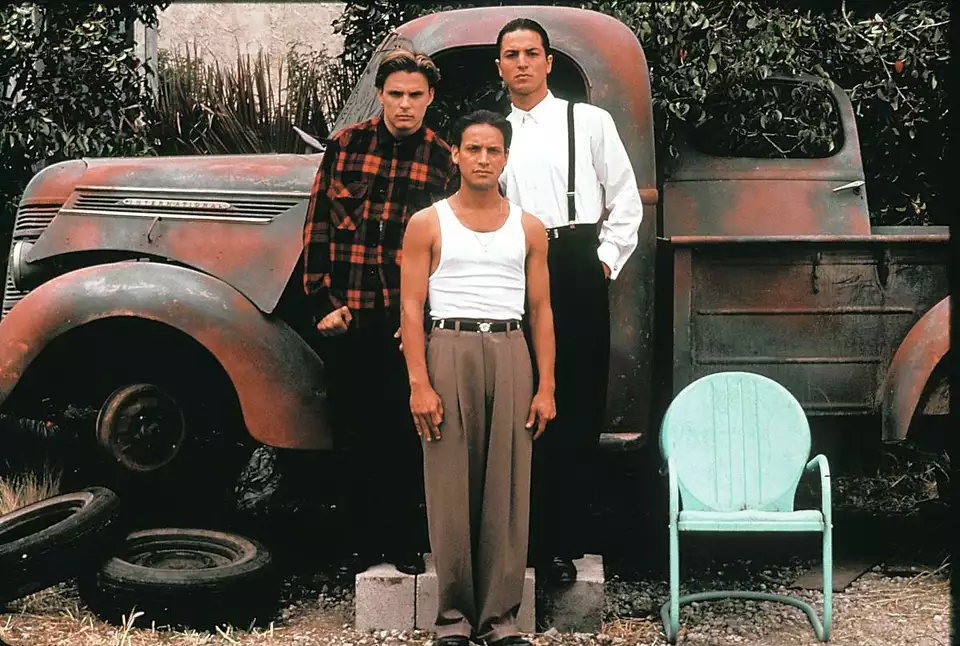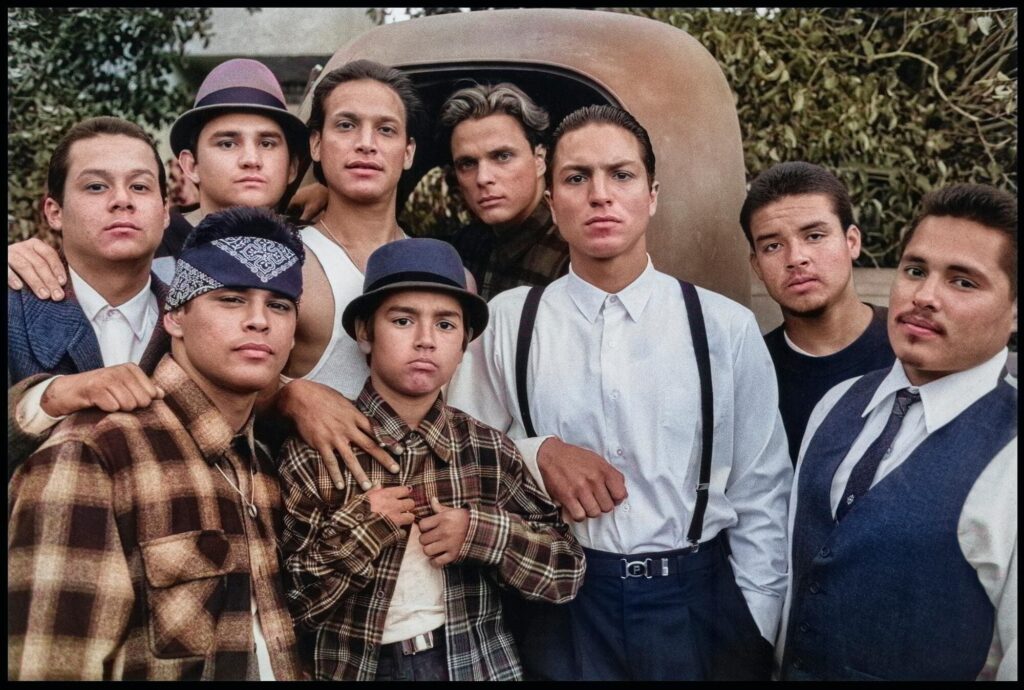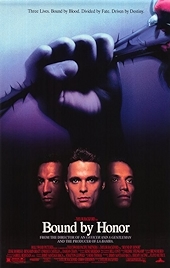Clearly intending to do for Chicanos what Scorsese and Coppola did for Italian Americans, 1993’s Blood In, Blood Out cannot be accused of a lack of ambition. A big, long, zeitgeist-tasting tale of life in and around the gangs inside and outside prison, it follows three East Los Angeles guys on a journey from callow youth to some sort of maturity, each winding up in a place he might not have expected.
Miklo, Cruz and Paco are three streetwise Chicanos. Spanish peppers their streetspeak as they swagger around their rough neighbourhood in cartoon exaggerations of masculinity. Cruz is a street artist with ambitions to be something more. Half-brother Paco is a cock of the walk who doesn’t know what to do with his aggression now his promising boxing career has been ended by injury. Miklo, the most pale-skinned of the three and reviled because of it, struggles to fit in with his cousins. He’s done some time and is now out on parole.
Over the course of about ten years, from the early 1970s into the 1980s, we track these three – Cruz into a dalliance with heroin that proves disastrous. Paco into the army and eventually into the police. But mostly Miklo, back into jail where he struggles to be accepted as a “brown” man in a milieu where you’ve got to be in one of three different gangs – black, white or brown: the Black Guerrilla Army; the Aryan Vanguard; or the Onda, which translates as Wave (presumably because it’s going to wash everything else off the beach).
To join the Onda, who don’t really want him, Miklo will have to pass his “blood in, blood out” initiation. He’ll have to kill someone. This will make him Onda for life, until his own death (blood out).
Director Taylor Hackford’s view of prison is a bleak one, largely of aggressive homosexual weightlifters eyeing up new arrivals for sexual pleasure and of a crooked regime where the guards stoke inter-racial competition as a way of maintaining control. The prison as metaphor for wider society is there, but Hackford’s attention to detail, and his way of marshalling his many actors, extras etc, especially in his busy set pieces, means it isn’t oppressive. For example, Miklo’s “blood in” killing is a neat exercise in tension as build-up, climax and release.
For all that, life in San Quentin (for that is where we are) verges on the prison cliché, with things at times so intensely macho and bitterly racialised that comic overload always threatens. Guys, so much snarling.
There are some interesting faces in this movie, people who’d go on to have actual careers. Danny Trejo, Ving Rhames and Billy Bob Thornton all have minor roles, while Delroy Lindo punches through as the Black Guerrilla Army leader, a boss who is both tough and dignified.
The casting is actually better on the fringes than it is at the centre. Damian Chapa is miscast as Miklo, his inability to connect to his character making Miklo’s transition from boy to man not just unconvincing but, far worse, uninteresting. Benjamin Bratt comes off a bit better as strutting, preening Paco. Best of all, though least well used, is Jesse Borrego as artist/junkie Cruz, the one whose talent should have helped him soar away out of the “barrios”.
Hackford’s film is well made, shot in that superwarm 1990s style that said “Hollywood not TV” (TV was all about the colour blue in those days). It’s slick, and is clearly in thrall to Scorsese, as are most of the actors, most of whom can’t wait to unburden themselves of the scene they’ve been rehearsing in front of the mirror at home.
This is a film that’s impressive in scale and execution but not in effect, for all the splendour of the various violent set pieces. Even so, it’s gone on to have a life of its own as a cult item, possibly on account of how under-represented Mexican-Americans are as protagonists of their own screen stories.
There was a wobble over the title and for a while the movie was shown as Bound by Honor. Nervousness over riots on the streets of LA was the concern, since the movie was released when the verdicts on the Rodney King case were about to be handed down and a re-run of the 1992 riots was feared.
In the end that never happened. In any case the film flopped, both at the box office and critically. It isn’t terrible, though there is something indefinably wrong with it, beyond the odd bad performance. Maybe the original five-hour cut needs to be consulted to find out what that is – the awkward inside/outside prison structure maybe?
At the moment we have the director’s three hour ten minute cut, which only adds an extra ten minutes to the theatrical running time. But there is talk of the five-hour cut having finally been found in an archive somewhere. Will it ever see the light of day? Will it be an improvement? Could be ideal viewing on a long-haul flight to somewhere if so…
Blood In, Blood Out – Watch it/buy it at Amazon
I am an Amazon affiliate
© Steve Morrissey 2024


